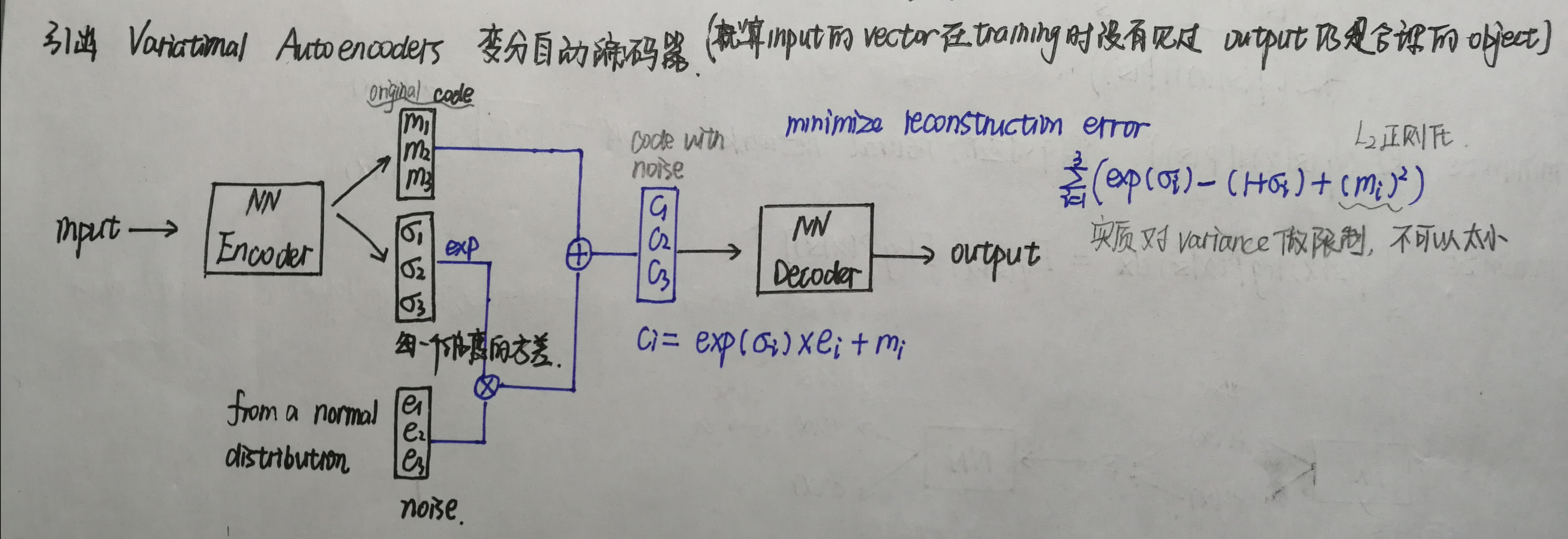import torch
from torch import nn, optim
from torch.utils.data import DataLoader
from torchvision import transforms, datasets
import visdom
1. 自编码器(Auto-Encoder)

class AE(nn.Module):
def __init__(self):
super(AE, self).__init__()
# [b, 784] => [b, 20]
self.encoder = nn.Sequential(
nn.Linear(784, 256),
nn.ReLU(),
nn.Linear(256, 64),
nn.ReLU(),
nn.Linear(64, 20),
nn.ReLU()
)
# [b, 20] => [b, 784]
self.decoder = nn.Sequential(
nn.Linear(20, 64),
nn.ReLU(),
nn.Linear(64, 256),
nn.ReLU(),
nn.Linear(256, 784),
nn.Sigmoid()
)
def forward(self, x): #x.shape=[b, 1, 28, 28]
batchsz = x.size(0)
x = x.view(batchsz, 784) #flatten
x = self.encoder(x) #encoder [b, 20]
x = self.decoder(x) #decoder [b, 784]
x = x.view(batchsz, 1, 28, 28) #reshape [b, 1, 28, 28]
return x, None
2. 变分自动编码器(Variational Auto-Encoder)

代码中的h和图中的ci,计算方法略有不同,代码中没有用指数。
KL散度计算公式(代码中与sigma相乘的torch.randn_like(sigma)符合正态分布):


class VAE(nn.Module):
def __init__(self):
super(VAE, self).__init__()
# [b, 784] => [b, 20]
self.encoder = nn.Sequential(
nn.Linear(784, 256),
nn.ReLU(),
nn.Linear(256, 64),
nn.ReLU(),
nn.Linear(64, 20),
nn.ReLU()
)
# [b, 20] => [b, 784]
self.decoder = nn.Sequential(
nn.Linear(10, 64),
nn.ReLU(),
nn.Linear(64, 256),
nn.ReLU(),
nn.Linear(256, 784),
nn.Sigmoid()
)
self.criteon = nn.MSELoss()
def forward(self, x): #x.shape=[b, 1, 28, 28]
batchsz = x.size(0)
x = x.view(batchsz, 784) #flatten
h_ = self.encoder(x) #encoder [b, 20], including mean and sigma
mu, sigma = h_.chunk(2, dim=1) #[b, 20] => mu[b, 10] and sigma[b, 10]
kld = 0.5 * torch.sum(mu**2 + sigma**2 - torch.log(1e-8 + sigma**2) - 1) / (batchsz*28*28) # KL散度计算
h = mu + sigma * torch.randn_like(sigma) # 再参数化,reparametrize trick, epison~N(0, 1)
x_hat = self.decoder(h) # decoder [b, 784]
x_hat = x_hat.view(batchsz, 1, 28, 28) # reshape [b, 1, 28, 28]
return x_hat, kld # 目标:最大化证据下界ELBO
3. MINIST数据集上分别调用上面的编码器
def main():
mnist_train = datasets.MNIST('mnist', train=True, transform=transforms.Compose([transforms.ToTensor()]), download=True)
mnist_train = DataLoader(mnist_train, batch_size=32, shuffle=True)
mnist_test = datasets.MNIST('mnist', train=False, transform=transforms.Compose([transforms.ToTensor()]), download=True)
mnist_test = DataLoader(mnist_test, batch_size=32, shuffle=True)
x, _ = iter(mnist_train).next() #x: torch.Size([32, 1, 28, 28]) _: torch.Size([32])
model = AE()
# model = VAE()
criteon = nn.MSELoss() #均方损失
optimizer = optim.Adam(model.parameters(), lr=1e-3)
print(model)
viz = visdom.Visdom()
for epoch in range(20):
for batchidx, (x, _) in enumerate(mnist_train):
x_hat, kld = model(x)
loss = criteon(x_hat, x) #x_hat和x的shape=[b, 1, 28, 28]
if kld is not None:
elbo = - loss - 1.0 * kld #elbo为证据下界
loss = - elbo
optimizer.zero_grad()
loss.backward()
optimizer.step()
print(epoch, 'loss:', loss.item())
# print(epoch, 'loss:', loss.item(), 'kld:', kld.item())
x, _ = iter(mnist_test).next()
with torch.no_grad():
x_hat, kld = model(x)
viz.images(x, nrow=8, win='x', opts=dict(title='x'))
viz.images(x_hat, nrow=8, win='x_hat', opts=dict(title='x_hat'))
if __name__ == '__main__':
main()
开启监听进程: python -m visdom.server
当调用AE时:

当调用VAE时:
